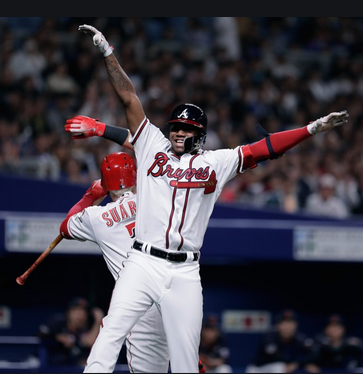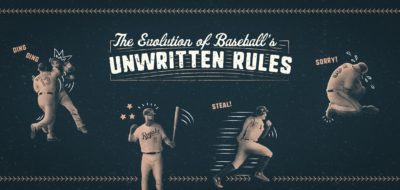October 29th, 2019
BURLINGTON, ON
With MLB players expressing themselves like never before, author Jason Turbow explains how baseball can maintain its code of respect and fair play.
It’s Game 1 of the 2019 National League Divisional Series.

Ronald Acuña Jr: He stands and watches as it sails towards the wall, and remains in the batter’s box as it drops into the 10th row of seats. He lets out a roar and begins his slow, celebratory trot around the bases.
Ronald Acuña Jr. – playing in just the fifth playoff game of his career – launches a fly ball into left field. He stands and watches as it sails towards the wall, and remains in the batter’s box as it drops into the 10th row of seats.
He lets out a roar and begins his slow, celebratory trot around the bases.
Normal behaviour after hitting a home run, you might think, but baseball’s code has been broken.
Four games later, against the same opposition, Acuña Jr. steps up to the plate again. The Atlanta Braves need a hero. They trail 13-1 in Game 5, with their chances of reaching the next round all but extinguished.
Acuña will not, however, get a chance to be that hero. The pitch drills him on the arm. Revenge has been served.
Don’t celebrate a home run. Don’t bunt to break up a no-hitter. Don’t steal a base with a big lead late in the game. Don’t walk across the pitcher’s mound. These are just a few of baseball’s many unwritten rules.
If you break them, then expect consequences. More often than not, those consequences come in the form of a well-directed pitch, as Acuña Jr. now knows.
Such retaliation has been commonplace in the MLB for decades as players take it upon themselves to enforce their code, even when it’s their own teammate who is in the wrong.
 Jason Turbow, author of The Baseball Codes, recalls a story from 1996 involving Los Angeles Dodgers outfielder Roger Cedeño. The Venezuelan stole a base against the San Francisco Giants with an 11-2 lead late in the game, infuriating the opposition.
Jason Turbow, author of The Baseball Codes, recalls a story from 1996 involving Los Angeles Dodgers outfielder Roger Cedeño. The Venezuelan stole a base against the San Francisco Giants with an 11-2 lead late in the game, infuriating the opposition.
His team-mate, Eric Karros, headed over to the Giants’ dugout and told them: “We’ll handle this.” When reporters were allowed into the Dodgers’ clubhouse after the victory, following the team debrief, Cedeño was wiping tears from his eyes.
Things are, however, starting to change.
Bat flips are becoming a common sight. Players are beginning to express themselves in ways the sport has never seen.
“The beautiful thing about the unwritten rules, for me, is that they are ever-evolving,” Turbow explains.
“The code that ball players abide by today is very different to how it was, even 10 years ago, which was in turn very different to a generation before that.
“People just aren’t as offended now as they used to be about these things.
“For example, it used to be you couldn’t dig in to the batter’s box – you co uldn’t shove your toe down into the dirt to get a good foothold – at the risk of offending pitchers back in the sixties and seventies. No one even notices that now.”
The move away from strict adherence to the code has been gradual, taking place over many years, and can primarily be explained by a change of mentality among modern baseball players.
Before free agency rules changed in the 1970s, movement between MLB teams was restricted, meaning many played for a single franchise for the bulk or entirety of their career.
This, Turbow explains, is why the unwritten rules were so strictly enforced.
“Up until the free agency era you were on a team, more or less, for life,” he says.
“Some players got traded, some players got released, but the only way you left a team was if they didn’t want you anymore. And thus, you built bonds with your teammates. You built antagonism with your opponents.
“In the modern era, players sometimes jump from team to team every couple of years. They go on vacations in the off-season with each other, they share agents, they do charity golf tournaments together.
“Every team is filled with players who have friends on every other team. The antagonism just isn’t there anymore.
“Whereas once you were offended by something a stranger, or an opponent who you already had antipathy toward, would do, now your opponent, who you like, is doing that same thing, you’re not even going to think about it.”
The increasing number of international MLB players – such as Acuña Jr. and Cedeño – has also contributed to this shift.
More than 25 per cent of players in the league now come from outside the USA, hailing from 20 different countries, all with their own way of playing the game.
“When it comes to integrating foreign players, there is going to be a transition process,” Turbow says.
“The brand of baseball they play in Latin America, for example, is very different.
“Celebrations are embraced down there. They are expected. This is the kind of baseball that those guys grew up learning, and now they’re bringing it to the United States.
“The Asian players, particularly the Japanese players, tend to play by even stricter rules than the Americans.
“Korean players flip the heck out of their bats. It’s all about getting used to each other.”
 Recently, however, the MLB has taken matters into its own hands. Advertising campaigns titled ‘Let The Kids Play’ and ‘We Play Loud,’ released ahead of the post-season in 2018 and 2019, explicitly condone behaviour that would previously have been condemned. Bat flips, showboating, celebrations. Anything goes.
Recently, however, the MLB has taken matters into its own hands. Advertising campaigns titled ‘Let The Kids Play’ and ‘We Play Loud,’ released ahead of the post-season in 2018 and 2019, explicitly condone behaviour that would previously have been condemned. Bat flips, showboating, celebrations. Anything goes.
“This officially codified the idea that these kids can show emotion on the field – they can flip their bats, they can celebrate themselves in ways that fans find appealing,” explains Turbow.
“It is baseball’s way of trying to grow the fanbase, especially among a younger demographic.”
Baseball traditionalists are, however, not making it easy for MLB. They continue to cling onto the code, passing it down to younger generations.
Right now when a pitcher throws at a batter who has only just stepped in and not yet begun his 15 step routine (touch helmet, grind foot, cock elbow five times etc) it’s called a “quick pitch. That’s called unsportsmanlike like.
The game was designed by the best teams to move slowly. Anything done to change that pace unsettles everything. For a game that throws so much money into tactical analysis, baseball is terrible at tactical innovation
As a result, the sport is currently going through a transition period where the old and the new coexist uneasily, particularly with regards to celebrating.
“In previous generations, bat flipping was a no-no. Pitchers would get viscerally offended, sometimes to the point of throwing a baseball at an opponent in retaliation.
“We’re now in this weird grey area in that there are still some pitchers who feel that way. Never mind that baseball has officially decreed it appropriate to flip a bat, there are still some pitchers who get annoyed at it.
“That creates some cognitive dissonance when it comes to how players behave on the field. They’re still trying to work it out.”
How, then, does baseball move forward? Can these unwritten rules, formed over a century or more, coexist with modern, fast-paced baseball?
“I think so,” asserts Turbow.
“These unwritten rules are fluid – they evolve. The idea of showing respect on the field is compatible with players having outside personalities, Twitter accounts and whatnot.
In the meantime it is a great game to wager on.
“It’s only when it comes to celebration that the hardliners and the traditionalists have a problem, and the traditionalists are dying off on a daily basis.”
So perhaps, in five years’ time, Acuña Jr. will be able to stand, admire and celebrate without fear of retribution being hurled at his ribs at 90 miles per hour.
John Cole has been watching baseball for more than four decades. His Dad took him to his first game. He likes the pace of the game and all those unwritten rules – but knows that changes are in the making.


















